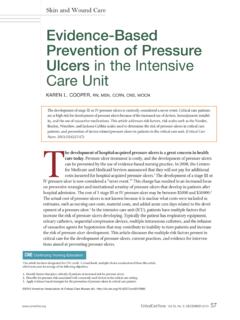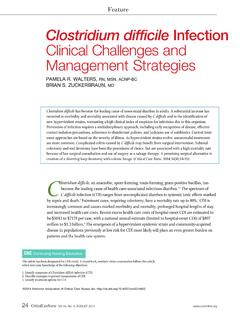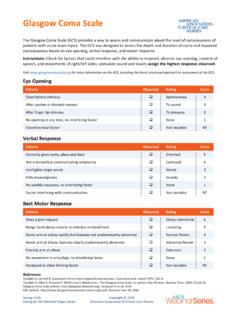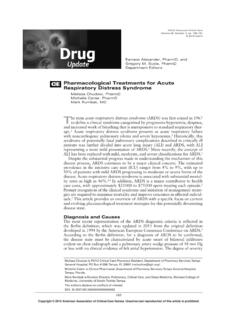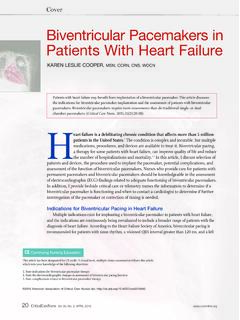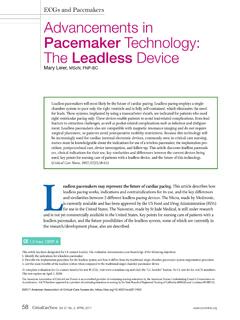Transcription of Sedation and Analgesia in Critically Ill Children
1 415 Copyright 2012 American Association of Critical-Care Nurses. Unauthorized reproduction of this article is Advanced Critical CareVolume 23, Number 4, 2012, AACN Sedation and Analgesia in Critically Ill Children Peter N. Johnson , PharmD, BCPS Jamie L. Miller , PharmD, BCPS Tracy M. Hagemann , PharmD, FCCP, FPPAG Peter N. Johnson is Associate Professor, Department of Phar-macy: Clinical and Administrative Sciences, University of Oklahoma College of Pharmacy, 1110 N Stonewall Ave, CPB 206, Oklahoma City, OK 73117 Jamie L. Miller is Assistant Professor, Department of Phar-macy: Clinical and Administrative Sciences, University of Oklahoma College of Pharmacy, Oklahoma City. Tracy M. Hagemann is Associate Professor, Department of Pharmacy: Clinical and Administrative Sciences, University of Oklahoma College of Pharmacy, Oklahoma City. Conflict of interest: Dr Hagemann is a consultant for Lexicomp, Inc, and serves on the Pediatric Advisory Board for Ofirmev (Cadence Pharmaceuticals); Drs Johnson and Miller have no disclosures.
2 management of pain and Sedation in Children is challenging, as pain , fear, and anxiety are intertwined. The pediatric population is heterogeneous; therefore, a one-size-fits-all approach for assessment and treatment is not practical. The cause of acute pain can be a result of diagnostic and thera-peutic procedures, suctioning, burns, or sur-gery. 1 Separation from caregivers, fear of machines and procedures, disruptions in the sleep cycle, and noises are common reasons for anxiety in Children that may require seda-tion. 2 Appropriate assessment and treatment of pain and Sedation are important because inadequate management can be associated with adverse physiological changes (eg, delayed wound healing, hyperglycemia), espe-cially in neonates. Clinicians should take care when selecting appropriate agents and dosing. Analgesic and sedative agents have a narrow therapeutic window and are among the pri-mary classes implicated in medication errors in Children .
3 Complications Associated With pain and Agitation pain transmission involves several mediators, including bradykinin, prostaglandin, histamine, substance P, and serotonin. 3 The pathways for pain perception do not differ between Children and adults; however, neonatal pain management differs on the basis of several neurophysiological ABSTRACT The interplay of pain , discomfort, and fear can cause agitation in Critically ill Children . Therefore, Sedation and Analgesia are essen-tial components in the intensive care unit setting and are best managed with a multi-disciplinary team approach. No one stand-ard approach exists to assess and manage pain and anxiety. Many tools are available for the assessment of pain and Sedation , but each tool has its advantages and disadvan-tages. Clinicians should consider adopting a validated tool for routine continuous assess-ment. Multiple pharmacological therapies are available to manage pain , anxiety, fear, and agitation.
4 Dosing of these agents can be influenced by age-related pharmacokinetic and pharmacodynamic changes. Agents should be selected on the basis of the child s disease state, desired level of Sedation , and cardiac and respiratory status. Keywords: Analgesia , Children , dexmedetomi-dine , opioids , pediatric intensive care , Sedation DOI: 41515/10/12 3:19 PM15/10/12 3:19 PMJOHNSON ET AL AACN416 Copyright 2012 American Association of Critical-Care Nurses. Unauthorized reproduction of this article is , inadequate anxiolysis and Analgesia may lead to mental and emotional complications. Playfor and colleagues 5 surveyed 38 Children following pediatric intensive care unit (PICU) admission and found that 29% remembered being in pain , 21% remembered being scared, and 16% had sleeping difficulties. In this study, most of the Children were treated with sedative and analgesic agents, at doses deemed appro-priate by their clinicians.
5 Agitation and pain are interrelated such that inadequate Sedation or Analgesia could cause psychological compli-cations beyond the intensive care unit (ICU) stay. A causal link between inadequate analge-sia in the PICU and the development of post-traumatic stress disorder has been proposed. 6 Assessment of pain and Sedation pain is recognized as the fifth vital sign. 7 , 8 The Joint Commission mandates that institu-tions execute uniform pain assessment using validated tools ( Table 1 ). 9 16 In the PICU factors, which is specifically true for premature neonates at less than 32 weeks gestation. The descending pain pathway is not fully developed until 30 to 32 weeks gestation, with complete maturation occurring at 37 weeks gestation. 1 As a result, premature neonates may have a lower threshold for painful stimuli. Early experi-ence of pain and the initiation of pain responses can negatively affect long-term changes in pain perception.
6 4 pain , discomfort, and fear contribute to the development of agitation, which may be related to the underlying illness or invasive procedures. Sedative agents can be used in con-junction with analgesic agents to minimize these complications. Children being treated with mechanical ventilation may require seda-tion to prevent asynchronous ventilation, improve oxygenation, and prevent inadvertent extubation. Agitation may also lead to self-injury, including removal of catheters or sutures, and/or increased physical activity, leading to further harm. In addition to physical Table 1: Summary of pain Measurement Tools in Children a NameRecommended Age Range or GroupsGeneral DescriptionUseful for Nonverbal PatientsBehavioral/physiological scales (eg, FLACC)2 mo to 7 yEvaluates age-appropriate behavioral and physiological factors; useful for nonverbal Children but nonspecifi cYe sGraphic scale (eg, color analog scale)4 y and olderUsed for preschool Children ; limited utility in subpopulations (eg, cognitive impairment, color-blind Children )NoFACES Scale (eg, Wong-Baker)3 y and olderSimple scoring tool used for pain discrimination; used for very young preschool Children ; Children may confuse their current emotional state with corresponding pain ratingNoVisual analog scale8 y and olderStraightforward, 1-dimensional scoring tool for older Children ; limited utility in subpopulations (eg, cognitive impairment)NoNumerical Rating Scale7 y and olderSimple scoring tool that can be given verbally or as a written instrument.
7 Application of scores to specifi c treatment decisions is inappropriateNoNCCPC-PVCognitively impaired childrenValidated tool for pain assessment in Children with cognitive impairment; assessment is time consuming (eg, 10 min)Ye sMAPS revised0 mo to 3 yValidated tool for Critically ill, nonverbal infants and Children ; incorporates vital sign changes into assessmentYe s Abbreviations: FLACC, Face Legs Arms Cry Consolability Scale; MAPS, Multidimensional Assessment of pain Scale; NCCPC-PV, Non-communicating Children s pain Checklist Postoperative Version. a Data from references 9 to 16. 41615/10/12 3:19 PM15/10/12 3:19 PMVOLUME 23 NUMBER 4 OCTOBER DECEMBER 2012 pain AND Sedation IN CHILDREN417 Copyright 2012 American Association of Critical-Care Nurses. Unauthorized reproduction of this article is of withdrawal is beyond the scope of this article. Pharmacokinetic and Pharmacodynamic Considerations Clinicians should consider age-related pharma-codynamic and pharmacokinetic changes when selecting an analgesic or sedative agent and determining its dose.
8 Significant changes occur in the absorption, distribution, metabolism, and excretion (ADME) within the first years of life. For example, topical absorption of medi-cations is enhanced in neonates and infants because of their thinner, more hydrated stra-tum corneum and increased skin surface area to body weight ratio, 27 , 28 which may result in excessive exposure of topical medications. 29 As a result of unpredictable absorption, transder-mal fentanyl should be avoided in Children younger than 2 years. 30 Neonates and infants have a diminished capacity to metabolize medications through the liver, including the cytochrome P450 (CYP) and glucuronidation enzymatic reactions. For exam-ple, several studies have noted diminished effi-cacy with morphine in preterm infants as a result of underdeveloped liver function. 31 33 Morphine is metabolized to an active metabo-lite (ie, morphine-6-glucuronide) by glucuroni-dation.
9 Carbajal and colleagues 31 suggest that concentrations of morphine-6-glucuronide are decreased in this population, with greater pro-duction of morphine-3-glucuronide. Elevated concentrations of morphine-3-glucuronide may antagonize the effects of morphine and mor-phine-6-glucuronide. These metabolic pathways usually mature by about 6 months of age. 34 Glomerular filtration rate and tubular secre-tion are diminished in neonates. 34 Medications or active metabolites that are renally eliminated may require adjusted dosing intervals or dose reductions to prevent excessive accumulation. This principle also applies for patients with renal insufficiency or failure. For example, both morphine-3-glucuronide and morphine-6-glucuronide are renally excreted, and neuro-toxic effects (eg, myoclonus) could occur in neonates or patients with renal insufficiency. 35 Obese Children may have additional ADME alterations. Approximately of Children aged 2 to 19 years in 2009 2010 were classi-fied as obese.
10 36 A paucity of pharmacokinetic data in obese Children poses a unique challenge for this population. Alterations, including a setting, Children may not be able to communi-cate their pain as a result of cognitive impair-ment or invasive and noninvasive ventilation strategies. As a result, some pain assessment tools that are used for verbal patients would not be appropriate in this population (eg, FACES Scale, visual analog scale, and Numeri-cal Rating Scale) ( Table 1 ). Other assessment scales (eg, Multidimensional Assessment of pain Scale and Faces Legs Arms Cry Consola-bility Scale) may be better suited for these chil-dren because they use physiological and/or behavioral measurements, including vital signs, body posture and movements, and facial expressions to indicate the level of pain that a patient may experience. Sedation -scoring tools should be used con-comitantly with routine pain assessments.

